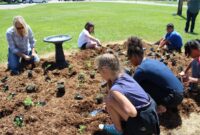Habitat Restoration Projects – State and local officials attended a groundbreaking ceremony during a ceremony to restore intertidal habitat and improve flood protection at Lookout Slough in Solano County.
SACRAMENTO, California – State, federal and local agencies came together today to celebrate the start of the largest intertidal habitat restoration project in California history. The Department of Resources (DWR) and Ecosystem Investment Partners (EIP) are collaborating on a project to restore intertidal habitat and improve flooding in Lookout Slough in Solano County. This is a multi-pronged effort to transform the site into a tidal wetland, create habitat and food production for delta smelt and other fish, as well as create new flood protection opportunities in the Yolo Bypass and reduce overall flood risk in the Sacramento area.
Habitat Restoration Projects

“Drought and climate change have increased the importance of multi-use projects like these,” said DWR Director Carla Nemeth. “This project will reduce flood risks to Central Valley communities and create much-needed habitat for Delta smelt and other endangered fish species.”
Details Revealed For Open Space, Natural Habitat Restoration As Part Of City’s 44th Drive Project
The Lookout Slough project is located west of the Liberty Island Ecological Reserve in the Sacramento-San Joaquin Delta. Part of this massive project includes building a new 25-foot seawall, digging 20 miles of open tidal channels, restoring natural habitat through grading, embankment and natural vegetation, and lowering the height of the Shag Slough seawall to 10 years. As a result of the storm, external levees were breached in several places around the facility. The project is expected to be completed by the end of 2024.
The Lookout Slough project is unique in demonstrating the effectiveness of innovative public-private partnerships in accelerating landscape restoration, which is critical to supporting wildlife and the environment as they cope with climate-induced impacts.
“Ecosystem Investment Partners is proud to partner with the Department of Resources to help meet the critical needs of California and its habitats,” said Adam Davis, managing partner of Ecosystem Investment Partners. “Lookout Slough gives us the opportunity to demonstrate that large-scale restoration projects can be delivered faster and at lower cost, and the positive results here create opportunities for greater investment in environmental projects in the future.”
In addition to benefits to fish, habitat and flood control, the site will provide recreational opportunities. Once completed, the public will have access to the new tidal channel for wildlife viewing, fishing and hunting.
Advancing Ecosystem Restoration With Smarter Permitting
Lookout Slough is one of many ecological restoration projects underway across New York State to support fish species and restore much-needed habitat to the Delta. Last week, DWR broke ground on the Fremont Weir Big Notch Project, which will restore 30,000 acres of bottomland salmon along the Yolo Bypass. In the coming weeks, DWR will also begin a intertidal habitat restoration project on Bradmore Island in Suisun Marsh, which will restore flooding to the site while also providing new recreational opportunities for the public. At the same event, DWR will also celebrate the completion of the Arnold Slough Intertidal Habitat Restoration Project, which converted approximately 161 acres of managed wetlands into tidal wetlands.
The Delta is the center of two of California’s largest surface transportation projects: the state project and the federal Central Valley project. The Delta provides some of the drinking water for 27 million Californians and most of the irrigation for the state’s $50 billion agricultural industry. The Delta spans 5 counties, covers more than 738,000 acres, and is home to more than 500,000 residents. Sign in front of the Silverado Canyon Restoration Project, December 2, 2023. The project is sponsored by the Orange County Transportation Authority (OCTA) with funding from the updated Measure M Highway Environmental Mitigation Plan. PHOTO CREDIT: ERIKA TAYLOR, Voice of OC.
Environmental impacts such as wildfires, overgrazing and invasive plant species are also destroying remaining open land.

“There is very little natural landscape left in Orange County,” said Leslie Hill, OCTA’s environmental mitigation program manager.
File:lake Hiawatha Shoreline Restoration Sign.jpg
For nearly a decade, Irvine Ranch Conservancy has worked to mitigate impacts in two environmentally sensitive areas: Agua Chinon and Silverado Canyon.
“Southern California has a lot of open space dedicated to states, cities and OC parks, but some of it is in terrible shape,” said Robert Freese, manager of the center’s Habitat Restoration and Enhancement Program. service.
“We want to restore it to what it looked like 300 or 400 years ago, before the impact,” he said.
View of West Stream, a geographic feature of the Limestone Canyon Nature Preserve, December 2, 2023. PHOTO CREDIT: ERICA TAYLOR, Voice of OC.
Two Tidal Habitat Restoration Projects In Solano County Support Delta Smelt Survival
Both projects are sponsored by the Orange County Transportation Authority (OCTA) with funding from the updated Measure M Highway Environmental Mitigation Program.
Measure M is a sales tax that funds improvements to Orange County’s highways, streets and transportation systems.
Marissa Espino, communications manager for OCTA, said the agency has funded more than 350 acres of habitat restoration in a total of 12 restoration projects.

The Lower Silverado Canyon project has received more than $1 million in funding. Agua Chinon was included in a joint project with Bee Flat Canyon, which received more than $1.5 million for restoration, Hill said.
Potential Habitat Restoration Projects Within The North Maumee Bay…
Agua Chinon restoration site, December 2, 2023. The project is sponsored by the Orange County Transportation Authority (OCTA) with funding from the updated Measure M Highway Environmental Mitigation Program. PHOTO CREDIT: ERIKA TAYLOR, Voice of OC.
The 6.1-acre Agua Chinon restoration project prioritizes the planting of native plants and the possible eradication of invasive species.
Agua Chinon begins at a geological feature known as “The Chute,” a natural sandstone formation in a limestone canyon. The river then crosses the 241 Toll Road and eventually flows into the San Diego River and Newport Back Bay.
Robert Freese at the West Sinks Lookout at Limestone Canyon Nature Preserve on December 2, 2023. Robert Freese is the project manager for the Irvine Ranch Conservancy’s Habitat Restoration and Enhancement Project. PHOTO CREDIT: ERICA TAYLOR, Voice of OC.
Welcome Michelle Cramer
“When we started in 2013, we did a baseline study to estimate the condition and proportion of vegetation needed, as well as the amount of non-native vegetation, and used that to determine what was reasonably achievable,” Freese said.
After removing these weeds, they planted wildflowers and other native plants such as mule butter, which grew slowly at first due to the dry soil.
After years of monitoring the health of native plants and eradicating invasive weeds, the project is nearing completion in 2020.

“The Irwin Ranch Conservancy produced a final report that met all the criteria for success, but the report did not reach the agencies in time before the fire, so they were unable to sign off on it,” Hill said.
Habitat Restoration Project Nears Completion In Nootka Sound
Following the 2020 Silverado Fire, heavy rains led to landslides on the mountain that further smothered vegetation.
The native plant seeds eventually sprouted into the ground, and in 2023 the project was deemed a success by state and federal wildlife agencies.
Lower Silverado Canyon restoration site, December 2, 2023. Algae (center) is where Silverado Creek flows during the rainy season. PHOTO CREDIT: ERIKA TAYLOR, Voice of OC.
Freeze said that while the Lower Silverado Canyon area also provides riverine habitat, it is very different from Aguachinon.
Habitat Restoration Volunteer
“The soil was severely damaged and covered in non-native grass,” Freese said. “We had to deal with a lot of stone material. We took a different approach: less seeding and more container plants.”
About 11,000 potted plants from the nursery were used to restore the area, according to Collin Ruff, project manager for the Irvine Ranch Conservancy, which is overseeing the project.
Robert Freese stands on dry kelp at the Lower Silverado Canyon restoration site, December 2, 2023. During the rainy season, Silverado Creek has algae flowing through it. PHOTO CREDIT: ERIKA TAYLOR, Voice of OC.

“A lot of the plants were uprooted and washed into the river, but some survived… We also had an influx of invasive weeds,” Freese said.
Crmc Funding For Habitat Restoration Projects
“Flooding is generally a natural process, but it can complicate the recovery process as conditions constantly change,” Love added.
To address this problem, they assessed the invasive plants in the area and replaced those that had been dispersed by the flooding.
Robert Freese stands next to mule butter, a California native plant, at the Lower Silverado Canyon restoration site on December 2, 2023. PHOTO CREDIT: ERIKA TAYLOR, Voice of OC.
“These plants have co-evolved with native wildlife, and there is a balance between wildlife and native species,” he said. “When native species are replaced by invasive, competing species, ecological relationships are affected. Animals don’t eat them, and insects don’t know what to do with them.”
Restoration Interventions Employed By Projects Across Habitat Type. (a)…
Robert Freese holds black mustard, an invasive plant, at the Agua Chinon restoration site on December 2, 2023. The plant is said to have been planted by Spanish missionaries in the 1600s. PHOTO CREDIT: ERIKA TAYLOR, Voice of OC.
“Many exotic plants grow very quickly and then dry up and turn into flames in early summer.
Habitat for humanity projects, coral reef restoration projects, forest restoration projects, salmon habitat restoration, ww2 aircraft restoration projects, coral restoration projects, restoration projects, ecosystem restoration projects, habitat projects, native habitat restoration, habitat restoration, habitat restoration jobs
- Dog Socialization Care Guide - August 11, 2024
- Best Dog-friendly Vacations - August 11, 2024
- Wildlife Conservation Organizations - August 10, 2024







